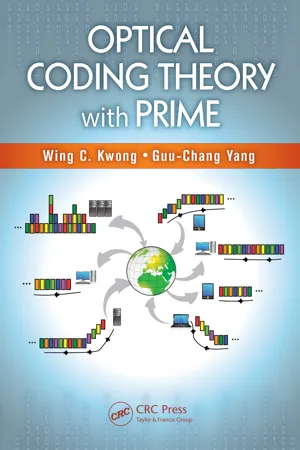
- 381 pages
- English
- ePUB (mobile friendly)
- Available on iOS & Android
Optical Coding Theory with Prime
About this book
Although several books cover the coding theory of wireless communications and the hardware technologies and coding techniques of optical CDMA, no book has been specifically dedicated to optical coding theory—until now. Written by renowned authorities in the field, Optical Coding Theory with Prime gathers together in one volume the fundamentals and developments of optical coding theory, with a focus on families of prime codes, supplemented with several families of non-prime codes. The book also explores potential applications to coding-based optical systems and networks.
Learn How to Construct and Analyze Optical Codes
The authors use a theorem-proof approach, breaking down theories into digestible form so that readers can understand the main message without searching through tedious proofs. The book begins with the mathematical tools needed to understand and apply optical coding theory, from Galois fields and matrices to Gaussian and combinatorial analytical tools. Using a wealth of examples, the authors show how optical codes are constructed and analyzed, and detail their performance in a variety of applications. The book examines families of 1-D and 2-D asynchronous and synchronous, multilength, and 3-D prime codes, and some non-prime codes.
Get a Working Knowledge of Optical Coding Theory to Help You Design Optical Systems and Networks
Prerequisites include a basic knowledge of linear algebra and coding theory, as well as a foundation in probability and communications theory. This book draws on the authors' extensive research to offer an authoritative reference on the emerging field of optical coding theory. In addition, it supplies a working knowledge of the theory and optical codes to help readers in the design of coding-based optical systems and networks.
For more on the technological aspects of optical CDMA, see Optical Code Division Multiple Access: Fundamentals and Applications (CRC Press 2005).
Frequently asked questions
- Essential is ideal for learners and professionals who enjoy exploring a wide range of subjects. Access the Essential Library with 800,000+ trusted titles and best-sellers across business, personal growth, and the humanities. Includes unlimited reading time and Standard Read Aloud voice.
- Complete: Perfect for advanced learners and researchers needing full, unrestricted access. Unlock 1.4M+ books across hundreds of subjects, including academic and specialized titles. The Complete Plan also includes advanced features like Premium Read Aloud and Research Assistant.
Please note we cannot support devices running on iOS 13 and Android 7 or earlier. Learn more about using the app.
Information
1 | Fundamental Materials and Tools |
Table of contents
- Cover
- Half Title
- Title Page
- Copyright Page
- Dedication
- Table of Contents
- List of Figures
- List of Tables
- Preface
- About the Authors
- Chapter 1 Fundamental Materials and Tools
- Chapter 2 Optical Coding Schemes
- Chapter 3 1-D Asynchronous Prime Codes
- Chapter 4 1-D Synchronous Prime Codes
- Chapter 5 2-D Asynchronous Prime Codes
- Chapter 6 2-D Synchronous Prime Codes
- Chapter 7 Multilength Prime Codes
- Chapter 8 3-D Prime Codes
- Index